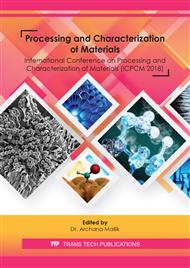[1]
R. Enright, N. Miljkovic, J. Sprittles, K. Nolan, R. Mitchell, and E. N. Wang, How coalescing droplets jump,, ACS Nano, vol. 8, no. 10, p.10352–10362, (2014).
DOI: 10.1021/nn503643m
Google Scholar
[2]
J. R. Lara and M. T. Holtzapple, Experimental investigation of dropwise condensation on hydrophobic heat exchangers. Part II: Effect of coatings and surface geometry,, Desalination, vol. 280, no. 1–3, p.363–369, (2011).
DOI: 10.1016/j.desal.2011.07.017
Google Scholar
[3]
B. Peng, X. Ma, Z. Lan, W. Xu, and R. Wen, Analysis of condensation heat transfer enhancement with dropwise-filmwise hybrid surface: Droplet sizes effect,, Int. J. Heat Mass Transf., vol. 77, no. December 2017, p.785–794, (2014).
DOI: 10.1016/j.ijheatmasstransfer.2014.05.052
Google Scholar
[4]
M. Edalatpour, L. Liu, A. M. Jacobi, K. F. Eid, and A. D. Sommers, Managing water on heat transfer surfaces: A critical review of techniques to modify surface wettability for applications with condensation or evaporation,, Appl. Energy, vol. 222, no. May, p.967–992, (2018).
DOI: 10.1016/j.apenergy.2018.03.178
Google Scholar
[5]
A. B. D. Cassie and S. Baxter, Wettability of porous surfaces,, Trans. Faraday Soc., vol. 40, no. 0, p.546, Jan. (1944).
DOI: 10.1039/tf9444000546
Google Scholar
[6]
P. Zhang and F. Y. Lv, A review of the recent advances in superhydrophobic surfaces and the emerging energy-related applications,, Energy, vol. 82, p.1068–1087, (2015).
DOI: 10.1016/j.energy.2015.01.061
Google Scholar
[7]
C.-H. Lu et al., Heat transfer model of dropwise condensation and experimental validation for surface with coating and groove at low pressure,, Heat Mass Transf., vol. 52, no. 1, p.113–126, (2016).
DOI: 10.1007/s00231-015-1641-0
Google Scholar
[8]
S. Lee et al., Heat transfer measurement during dropwise condensation using micro/nano-scale porous surface,, Int. J. Heat Mass Transf., vol. 65, p.619–626, (2013).
DOI: 10.1016/j.ijheatmasstransfer.2013.06.016
Google Scholar
[9]
A. D. Sommers and A. M. Jacobi, Wetting phenomena on micro-grooved aluminum surfaces and modeling of the critical droplet size,, J. Colloid Interface Sci., vol. 328, no. 2, p.402–411, (2008).
DOI: 10.1016/j.jcis.2008.09.023
Google Scholar
[10]
B. Qi, J. Zhou, J. Wei, and X. Li, Study on the wettability and condensation heat transfer of sine-shaped micro-grooved surfaces,, Exp. Therm. Fluid Sci., vol. 90, no. September 2017, p.28–36, (2018).
DOI: 10.1016/j.expthermflusci.2017.09.002
Google Scholar
[11]
C. Ma, S. Bai, X. Peng, and Y. Meng, Anisotropic wettability of laser micro-grooved SiC surfaces,, Appl. Surf. Sci., vol. 284, p.930–935, (2013).
DOI: 10.1016/j.apsusc.2013.08.055
Google Scholar
[12]
P. Li, J. Xie, J. Cheng, and K. K. Wu, Anisotropic wetting properties on a precision-ground micro-V-grooved Si surface related to their micro-characterized variables,, J. Micromechanics Microengineering, vol. 24, no. 7, (2014).
DOI: 10.1088/0960-1317/24/7/075004
Google Scholar
[13]
W. Xu, Z. Lan, B. Peng, R. Wen, Y. Chen, and X. Ma, Directional Movement of Droplets in Grooves: Suspended or Immersed?, Sci. Rep., vol. 6, p.1–11, (2016).
DOI: 10.1038/srep18836
Google Scholar
[14]
M. Izumi, S. Kumagai, R. Shimada, and N. Yamakawa, Heat transfer enhancement of dropwise condensation on a vertical surface with round shaped grooves,, Exp. Therm. Fluid Sci., vol. 28, no. 2–3, p.243–248, (2004).
DOI: 10.1016/s0894-1777(03)00046-3
Google Scholar
[15]
Y. Zhong, A. M. Jacobi, and J. G. Georgiadis, Effects of surface chemistry and groove geometry on wetting characteristics and droplet motion of water condensate on surfaces with rectangular microgrooves,, Int. J. Heat Mass Transf., vol. 57, no. 2, p.629–641, (2013).
DOI: 10.1016/j.ijheatmasstransfer.2012.10.056
Google Scholar
[16]
K. M. Tanvir Ahmmed, Colin Grambow and Anne-Marie Kietzig, Fabrication of Micro/Nano Structures on Metals by Femtosecond Laser Micromachining, Micromachines, pp.1219-1253, 2014,.
DOI: 10.3390/mi5041219
Google Scholar
[17]
S.J. Kline, F.A. McClintock, Describing uncertainties in single-sample experiments, Mech. Eng. (American Society Mech. Eng.), vol. 75, p.3–8.
Google Scholar


